A lot of people who don’t garden think the definition of gardening is putting plants in the ground. While that’s a logical assumption to make - it’s like calling stirring a pot, cooking.
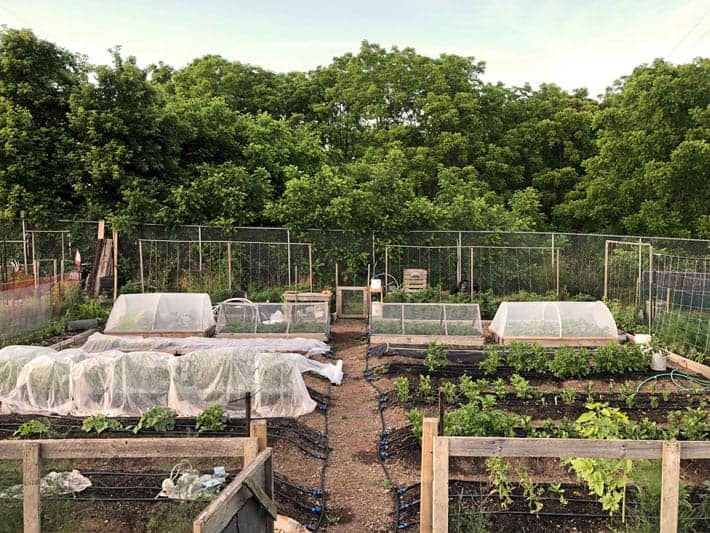
The truth of the matter is, pushing some soil aside and sticking a plant in a hole is only the teeniest, tiniest part of what gardening is. Keeping that plant alive? THAT’S GARDENING.
I need you to understand two things right now about the upcoming gardening season if you’re new to this vegetable growing stuff.
1. You will suddenly realize that nothing in the world is as miraculous as planting a seed, having it burst forth with life and then a few months later eating it with ketchup.
2. You will flip between moods of euphoria and despair often within seconds of each other.
The euphoria is the result of spending hours nurturing plants and growing your own food.
The despair is the result of spending hours nurturing plants and growing your own food -only to have it assaulted by pests and disease right before your very eyes.
That my friends, is gardening. If you think you can handle all of that, you’re ready to move onto the next step in creating your vegetable garden.
Welcome to June, the first month of keeping things alive.
What to Expect From June
By June all the plants are hopefully in the ground. The next few gardening months are dedicated to keeping the bugs, animals, weeds and disease at bay. And yes, no matter where you live you will find animals like this in your the garden.
If you get behind on any of these gardening tasks it's hard to come back from it.
But if you dedicate just a few minutes every day to each of these things you’ll have everything 100% completely under control all summer long. (hahahaha)
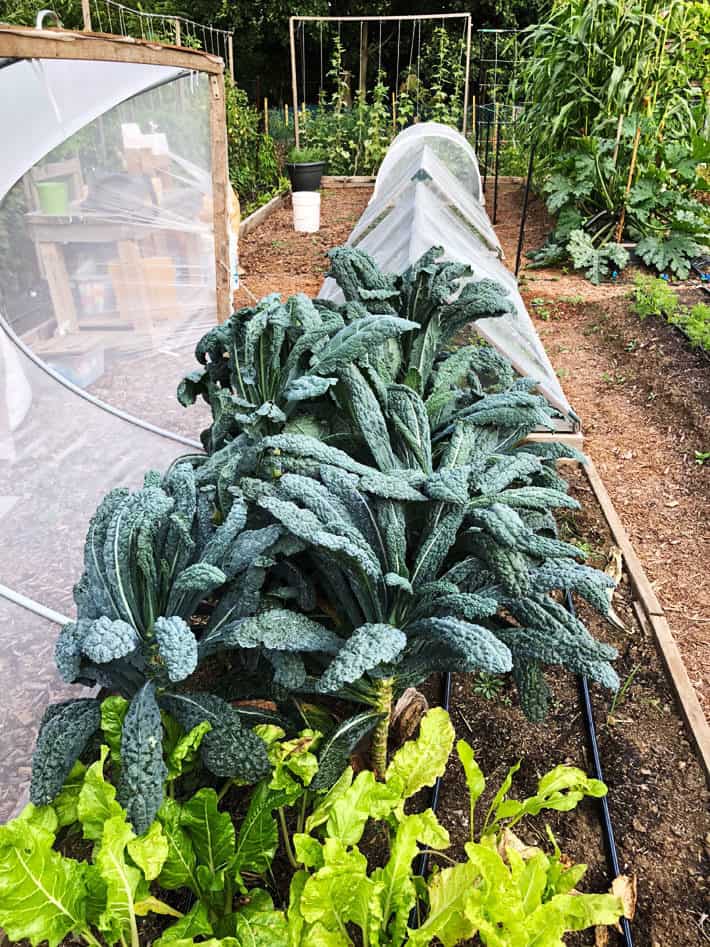
I rarely have things 100% under control all summer long and neither will you. And that's O.K. You're not growing an imaginary Pinterest garden. You're growing a real one.
BUT you really do need to keep on top of things. In just a few days two or three weeds can turn into a scene from Apocalypse Now.
Just trust me on this. In June, July and August it’s much easier to keep control of everything if you never let it get out of control.

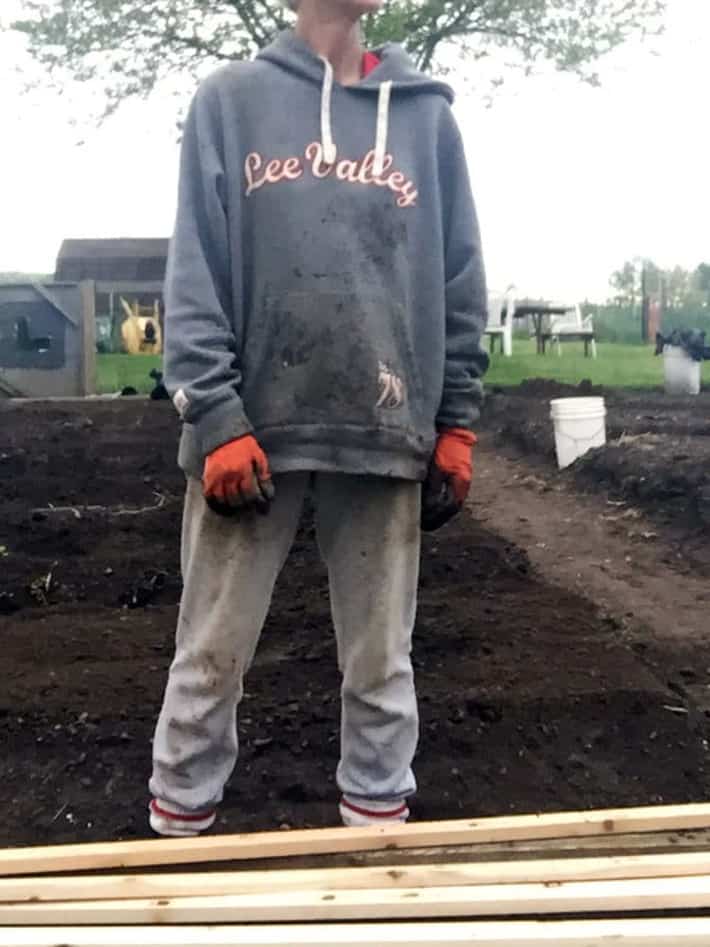
Always remember that Pinterest gardening isn't the same as real gardening.
karen bertelsen
There are people up at my garden who can be there the whole day and still look like they’d be able to go out for dinner straight from the garden. With the Queen. I became this mess after 4.5 seconds in my plot.
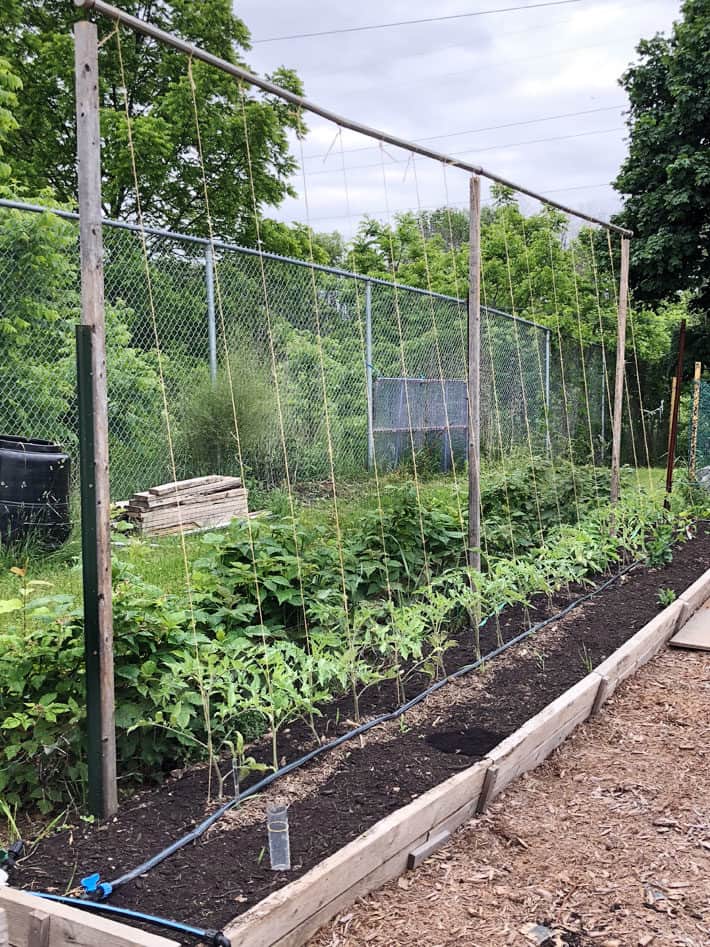
GARDEN TASKS FOR JUNE
Keeping Everything Alive
- Weed regularly, check for pests and use the control measures I'm teaching you.
- Stake and tie up plants as they need it.
- Stop harvesting asparagus so it can build up strength for the next year’s growth.
- If you have any last heat loving plants that still need to be planted get those into the ground.
- If you’re growing basil, pinch the top of the plant back. It will turn your leggy, spindly basil into a compact bush. As long as your basil is at least 8” high it’s ready to pinch.
Weed EVERY time you’re in the garden. I'm going to keep saying that.
I figured out a few years ago that the best way to weed is to do it in short bursts. So every time I’m at the garden no matter how short that time is, I weed.
Even if it doesn’t look like it needs it, I run my dutch hoe over my beds just to let the weeds know that I’m there and I’m the boss of them.
karen bertelsen
👆
Doing this one thing reduces weeds through the whole season plus it reduces them for the next year.
The more years you get rid of weeds BEFORE they flower and go to seed, the less and less weeds you’ll have every year.
The MOST important thing to keep in mind when you’re weeding is YOU HAVE TO PULL THE WEED BEFORE IT GOES TO SEED.
If the weed is flowering it needs to get ripped out NOW. Because as soon as it flowers, it will go to seed, drops those seeds and then you’re done for. You’ve just started an entirely new generation of weeds.
PESTS AND SOLUTIONS
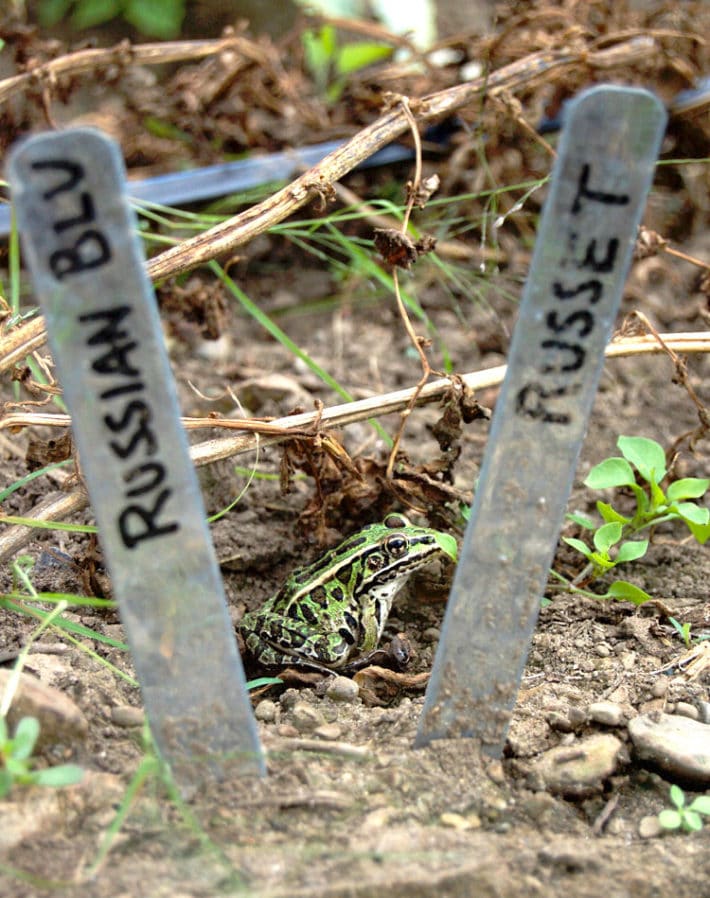
The pests and solutions will be the same this month as they were last month so reference that article if you need reminding. But here are 3 big ones I want to remind you about.
Bug Patrol
June is when the bugs really start marching around like they own the place. Particularly invasive and destructive in this month are cucumber beetles, cabbage moth and cutworm.
Cucumber Beetles
If you haven’t put netting over your plants to protect them from cucumber beetles, do your best to hand pick them off. Cucumber beetles can eat entire small seedlings almost overnight if they’re travelling in packs.
Later in the season when your cucumbers are just ripening the vine will develop wilt for what appears like no reason at all and entirely die within a couple of days.
It’s caused called bacterial wilt and it’s caused by the mere presence of cucumber beetles. And there’s nothing you can do to save your plant if it gets the disease. So deal with the cucumber beetles when you see them.
Plants affected: cucumbers, beans, squash, pumpkin.
Cabbage Moth
Now is when you’ll notice the small, erratically flying white moth flitting around your garden. In your former life when you didn’t know better you probably thought they were cute.
They’ll lay eggs on all your brassica plants and those eggs will hatch into tiny green caterpillars which eventually turn into large green caterpillars that will eat and poop alllllll over your vegetables.
They often do so much damage the plant can’t recover. Either that or you can’t recover after seeing a juicy caterpillar peek its head out at you as you shove a floret of your newly grown broccoli into your mouth.
Netting is your best solution but a once to twice a month spray of BTK on your brassicas (top and bottom of leaves) can help a lot.
Plants affected: kale, cabbage, broccoli, swiss chard, Brussels sprouts, cauliflower.
Cutworm
Cutworm are actually caterpillars from various moths. They overwinter under soil and then peep up at night to go out for dinner. They’re not particularly adventurous so they eat the first thing they bump their head into which is usually the stem of your seedlings.
Then they just start chewing until they’ve literally chewed through every stem they’ve come into contact with. It will look just like someone took scissors to your plants.
Since these live in the earth row cover will do nothing to deter them.
Instead, cut a plastic bottle off at the top and bottom and place it over the seedling to act like a collar. It will prevent the cutworm from getting to the stem.
You can do the same thing by wrapping cardboard or a toilet paper roll around the stem but the cardboard will get soggy and stop doing its job over time. Hopefully by then your plant will be large enough to survive cutworm damage.
Plants affected: beans, corn, lettuce, cabbage.
But the best solution you can have for bugs? Frogs. Frogs and toads will take care of a lot of bugs so make your garden toad and frog friendly by propping a few upside down clay pots around so they can use them as shelter and keeping some dishes of water around for them to soak in.
TOOLS
You’ll have all the same standard tools as I mentioned last month (dutch hoe, clippers, trowel, shovel, gardening gloves, stakes/cages, row cover, compost bin) you’ll just be using them more often this month.
- Run your weeding hoe over the garden for at least 10 minutes a day to keep weeds in check.
- Clip off any dead or already diseased leaves/branches.
- Stake your tomatoes, beans, cucumbers and anything else that climbs to keep it off of the ground. This goes a long way to preventing disease and inevitable death. For the plant I mean of course.
- Check your row cover for holes and patch them or pinch them together with clips.
- When you throw things into your compost bin, if you have time, cut stems etc. into smaller pieces. The smaller the pieces the fast it will compost. And TURN your compost. Just heave it around. Turning your compost is the key to creating fast compost.
If you have a small compost pile this DIY compost turner works great. If you have a BIG compost pile, use a fork to move and turn it over.
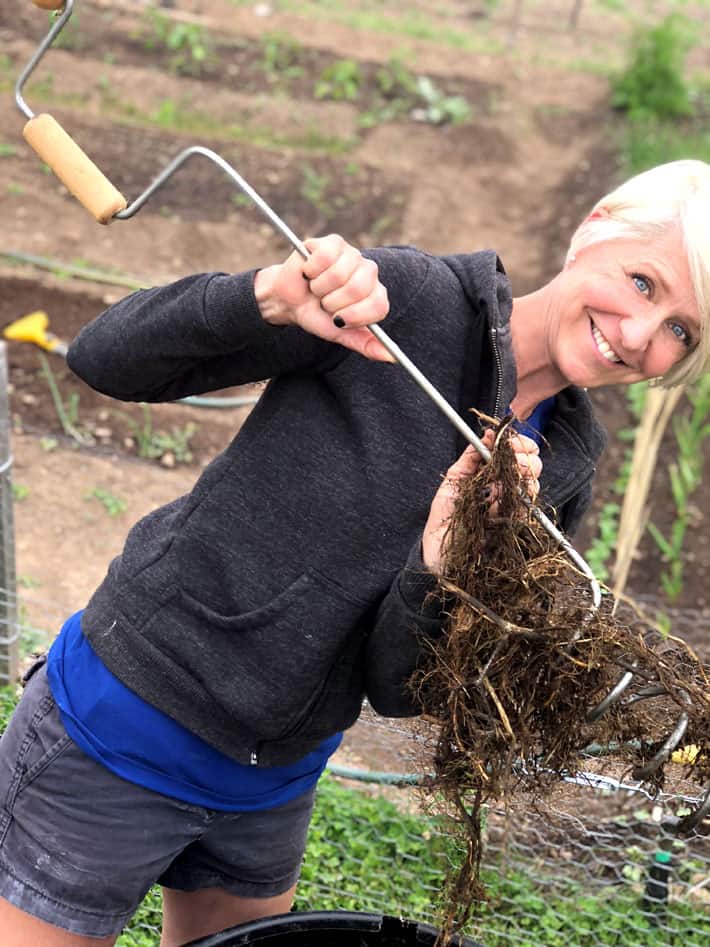
WHAT CAN BE PLANTED THIS MONTH
The only things you might still need to plant are really heat loving seeds and plants like sweet potatoes (here’s an entire guide to growing sweet potatoes), luffa (here's an entire guide to growing luffa) and corn. All of these things benefit from laying down some biodegradable thermal mulch on the soil a week or two before planting. It heats the soil up by 10 degrees which these particular plants LOVE.
Things are going to get interesting next month when I introduce you to the wonderful world of pest control … via snakes.

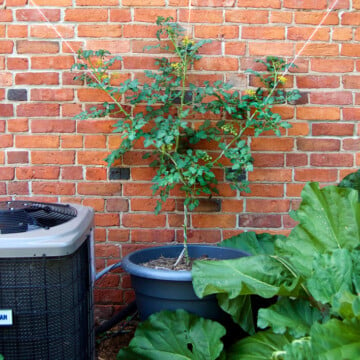


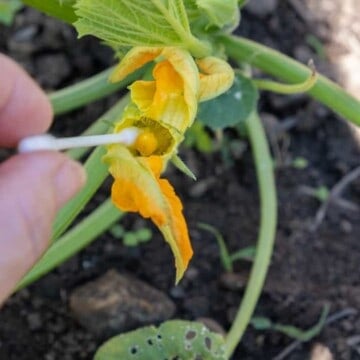
Hi Karen, Thank you for all the tips and tricks to maintaining a garden.
I have done a porch. It has been fun and easier for me to manage. I appreciate your ideas and skills.
Thank you again.
Marsha Beck
Thanks Marsha! Let me know if you ever have any questions. ~ karen!
Thanks for this super timely post and great advice. Peculiar weather and strange temperatures are the issue here so I'm into the second planting. Pulling out the stuff that is bolting and putting in another crop of radish and lettuce. Been eating all kinds of snap and snow peas. Broad beans will be ready soon. Strawberry crop is finito as is the early broccoli. Making space for bush and pole beans while waiting for the zucch, spag squash, tomatoes etc. It all feels super early. Yoicks. Hoping my cistern water lasts through August. So this is what climate change looks like on the "Wet Coast".
It's been odd weather here as well. It was blinding hot for a few days then COLD. Now it's heating up again but mainly in terms of the humidity. I got most everything in late so I won't be harvesting a thing other than lettuce (which hasn't bolted yet!) and maybe a few beets for a while. Plus you know, cucumber beetles .. so I have to reseed a few things that they've already killed. ~ karen!
what do you do with all that kale?
Throw it away. ;) Just kidding. I mainly use it for making this salad. There's another salad with roasted squash I use it for as well. I pick the lower leaves and the kale continues to grow and thrive all summer and fall. In the winter, I leave it in the ground and continue to pick from it until about January. ~ karen!
I love your short, to the point instructions - I can remember them!
Even we confirmed non-gardeners can truly appreciate the near herculean efforts combined with an amassed knowledge base that work in tandem to bring the harvest to our tables. I salute you Miss Karen, for sharing the tasks, trudgery and joys one can find in the gardening arts.
Hi Karen, HELP! I've started spraying my cukes and tomato plants regularly with your recommended vinegar solution to stave off powdery mildew, and so far, so good. But I am plagued by those vile creatures called earwigs! They are destroying my lettuce, peppers, and basil, along with my Echinacea and other flowering plants. Diatomaceous earth won't work, because it rains every day. So what can I do? Thank you!
Hi Carol! I hate to say this but I've never had trouble with earwigs so I really don't know how to control them! Not first hand anyway. My first thought was traps, like slugs. Like I said I haven't tried it so I can't guarantee it works or anything but Mother Earth News has a good article on an earwig trap. ~ karen!
Hi Karen
Great information!
I think the critter you are keeping out of your brassicas is the cabbage white butterfly not the spongy moth which feeds on trees. Those "cabbage worms" are the worst! My kid is permanently scarred from a cooked broccoli incident in her childhood (before I used netting.) Now there isn't a brassica I grow that doesn't get the net.
Yes!!! And of course I know that, lol. I had been talking with a fellow gardener just prior about the "spongy" moth. Ill go correct the post now. Thanks! ~ karen
The cut plastic bottles over plants to protect from cutworms sounds much easier than the old panty hose, cut into sections, and put over plant stems.
I use the empty 2 Qt.cardboard milk cartons, cut the bottoms off and cut them in half to make 2 collars. I save them all winter to use in the spring. I use them only on young tomato and pepper plants as those are the most favorite buffet dish of our local cutworms.
That's a great idea! ~ karen
Thank you Karen.
I am enjoying so much your monthly what to do in the garden approach. It helps a garden newbie to better organize and understand the garden. Your clear and easy to understand information has produced a huge difference for my garden this spring. Already the leeks, broccoli, and potatoes (both types) have benefited from your garden know how.
That's great AJ, thanks for letting me know. I know that where I garden row covers are a game changer. I don't think I'd be harvesting anything if it weren't for row cover! ~ karen
Hi, Karen! I need help with my cucumbers. I just bought the netting to cover them to protect them from pickleworms, which usually arrive in late June and destroy all my cucumbers. I saw your post about the covers and I thought that this is exactly what I need. However, it occurred to me that the cover will also stop the bees thar pollinate the cucumbers. So how do the cucumbers get pollinated if they are growing under the covers? Should I just go to neem oil? Thank you for any insight on this connindrum.
Hi Rozi. Somehow flies made their way into the tent (along with a few cucumber beetles which I was trying to keep out!) Even though they don't get any of the glory, flies make fantastic pollinators. So you may end up with smaller pollinators inside but still keep the larger pickleworm moths out. ~ karen!
Thank you! I will put up the tent. I got the AG-15. I never knew flies pollinate.
Hi Karen
A word on weeding. We have been doing this for 30 years and it works well. When we cut our lawn we bag our grass clippings ( we do not send them to the city recycling a plus plus). We bag our lawn because we have a pool, therefore the clippings do not get tracked into the pool. After the vegetable garden is planted we put the clippings in between the vegetable rows about 4-6 inches thick. This does 3 things. We never have to weed or hoe, saves on watering and it feeds the soil. Each grass blade has 6% nitrogen in the blade itself. We were under the assumption that nitrogen was taken out of the soil to break down the grass mulch. Not so, only a small amount of nitrogen is used in the top 2 inches of the soil. This is verified by Robert Pavlis a bio chemist out of Guelph. he has an excellent site . The link is www. Gardenmyths.com. He also has written books on garden myths. He field tests etc.
doesn't this bring many grass seeds into the garden?
Crikey! Sincere props for everyone who tends a garden or is otherwise outstanding in their field.
I was gonna ask what you do in your free time but was askeered you'd drive the 8 hours from your place to mine just to punch me in the nose. And I'd deserve it.
Best wishes for a bountiful harvest from a sincere vegetable buyer at my local grocery store.